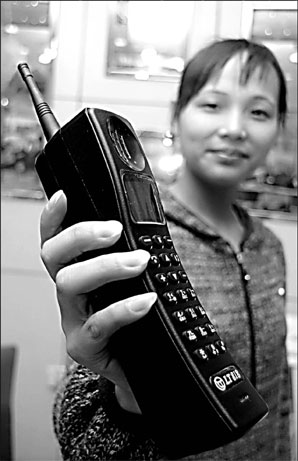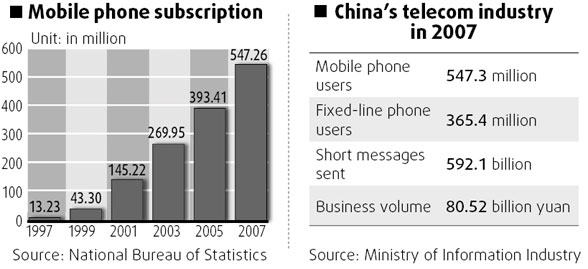

Xu Feng still remembers the day he got his first mobile phone 21 years ago.
In December 1987, one of Xu's relatives who worked at Guangdong Post & Telecom management Bureau told him the government institution was going to make 100 cell phones available in the name of supporting the upcoming 6th National Athletic Games and asked whether he was interested in buying one.

Xu, a tech-savvy guy in his 20s, decided to take the offer, which made him one of China's first mobile phone users.
"At that time, the government still didn't know how to price the phones, so they told me to pay a deposit of 20,000 yuan and let me take the mobile phone," recalls Xu.
The mobile phone that Xu took 21 years ago is far from the slim and stylish pocket device that we are familiar with now.
The handset was as large as a brick and weighed around two pounds, which made it resemble a weapon in many Hong Kong movies at the time.
Xu still remember the curiosity and envy on people's face when he told them the "brick" he was holding was a wireless device that could make phone calls. To show off he even made a call to Hong Kong in front of a crowd of friends.
Under tight control
In 1987, mobile telecommunication was still regarded as a sensitive industry that could easily raise national security issues and even ideological debates. By the end of 1987, the number of mobile phone users like Xu only numbered 700 in China, most of whom were businesspersons, officials and military users.
Because of the industry was strictly regulated at that time, demand for mobile phones greatly surpassed the supply. In some underground markets in China, a handset was sold at 60,000 yuan, not including the phone bill which could reach as high as 10,000 yuan per month.
"At that time, a mobile phone was a tag of wealth and upper social status," wrote Shi Wei, a researcher with the Institute of the Economic System and Management under National Development and Reform Commission (NDRC), in an article published last year. "For most people, its social implications have far outpaced its real functions."
In the first six months, Xu's mobile phone could be used only within Guangzhou. The service was later gradually expanded into other cities including Shenzhen, Shanghai and Beijing.
Mobile phones did not see an explosive growth until the late 1990s when China started to commercialize its mobile telecommunication industry and adopted the second generation mobile phone technologies, GSM and CDMA, which, compared with the old analog technology, provided a larger service capacity and value added services such as short text messages.

In the 1980s and early 1990s, both China's fixed-line and mobile networks were exclusively run by China's Ministry of Posts and Telecommunications, instead of telephone companies.
Even when the service became available to the general public, it was difficult to sign up due to the bureaucracy.
For instance, by the end of 1992, there was a waiting list of 1 million households wanting landline service.
They had to spend 5,000 yuan to 6,000 yuan to sign up and it usually took several months, or even years before the phone was installed as profits and prompt service were not what the government cared about. In the mobile phone sector, the situation was even worse due to the monopoly.
Deregulation and restructuring
Noticeably, the bureaucracy in China's mobile telecommunication industry in the mid 1990s also gave rise to the popularity of pagers. Although the fever quickly faded in the early 2000s as mobile phone calls became cheaper, the beeper subscriber base still reached 46.74 million by the end of 1999.
With the deepening of the reforms and opening-up in the country, the government started pondering introducing competition into the telecom market. As part of that effort, China Unicom, a new telephone company, was established in 1994 to operate mobile phone services.
With the help of foreign investors, China Unicom built GSM (Global System for Mobile Communications) networks in Beijing, Tianjin, Shanghai and Guangzhou in the first year of its establishment and then expanded into other cities to build a nationwide network. In 2002, China Unicom also launched another nationwide mobile network based on CDMA technology.
The establishment of China Unicom was hailed as a landmark in the reform of China's telecom industry.
Chen Ruming, a veteran in China's telecom industry, says the establishment of China Unicom significantly promoted the mass application of mobile telecommunications in China.
Also in 1994, China Ministry of Posts and Telecommunications decided to make its telecom business arm an independent company, which later become China Telecom. The company later grew into a corporate behemoth and was ordered to break up into two companies in 2000 and form China Mobile to offer GSM mobile phone services and another one which retained the name of China Telecom and operated solely fixed-line services.
More significantly, the spin-off of telephone companies from the government boosted the domestic telecom market.
From 1987 to 1997, the number of China's mobile phone users increased from zero to more than 3 million. The number quickly surged to 145 million in 2001 and surpassed the 500 million mark last year.
Rise of domestic manufacturers
The rapid uptake of China's mobile communications market is due to not only more carriers, but also competition among handset manufacturers, which has been fiercer than elsewhere in the world.
In China's analog network time, Motorola was the undisputed king, where the company's expensive black brick-like 8900 and 9900 models were a symbol of affluence for most of the Chinese businesspeople at that time.
Motorola maintained the monopoly until 1994 when Wu Jichuan, then minister of Communications, Posts and Telegraphs, was invited to make a test call in an industry forum based on GSM technology with former Nokia CEO Jorma Ollila, who sensed opportunity from China's upcoming deployment of the second generation network and decided to increase Finnish company's investment in the country.
In the following years, foreign companies including Nokia, Ericson and pioneer Motorola have all increased their presence in China where they started building new factories and establishing joint ventures with local partners and significant reduced the handset prices.
However, the most significant uptake did not come until the rise of domestic mobile phone manufacturers.
Foreign companies' huge investments as well as their monopoly on related technologies, ensured they dominated the market. By the end of 1999, foreign companies accounted for over 90 percent of China's mobile phone market.
As part of its effort to protect the domestic manufacturers, the Chinese government introduced a new system for mobile phone manufacturing in December 1998.
It required a license from regulators for manufacturing and selling handsets in the country and set a higher standard for foreign companies because it required foreign manufacturers to export at least 60 percent of their handsets produced in China.
As a result of the regulation, Chinese handset manufacturers such as TCL, Panda and Ningbo Bird have seen a rapid growth, which significantly intensified the market competition.
Affordable phones
In 2000, the Chinese mobile phone makers began penetrating into China's rural areas with cheaper models at a time when foreign vendors still focused on bigger cities.
Such a strategy, according to experts, has greatly accelerated the development of mobile phones in the countryside and hastened the explosive growth of China's mobile users.
The rapid rise of hard-charging local players squeezed many foreign players such as Siemens, Alcatel, Panasonic out of the market.
To counter the home-grown players, Nokia and Motorola revamped their strategies by expanding into the rural markets and introducing even cheaper models that were affordable for average Chinese.
In 2002, the government engineered a breakup of China Telecom as part of its effort to promote the competition in the fixed-line telephone companies.
That saw China Telecom split into two companies, China Telecom and China Netcom. Yet the government apparently still did not foresee increasing mobile trend. Both China Telecom and China Netcom saw their fixed-line business eroded by their mobile phone rivals, but the government has had kept a tight grip on awarding fixed-line carriers licenses to move into the more lucrative mobile sector.
To fight back, fixed-line carriers introduced the Xiaolingtong, or PHS (personal handy-phone service), a limited mobility service.
That added fuel to the competition, followed by significant drops in costs in making mobile phone calls.
These days there are still calls for the government to further cut the fees for making mobile phone calls, but owning a decent handset model and making calls are affordable for many Chinese.
These days a handset is no longer a luxury for the priviledged.
Xu Feng did not stop using his first phone until December 2001 when China Mobile closed the analog network and replaced it with GSM network.
Now, the handset has become an antique and a personal collectable that Xu says he will keep forever.

(China Daily 04/28/2008 page2)













